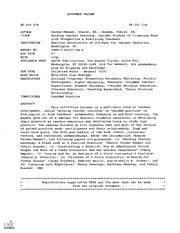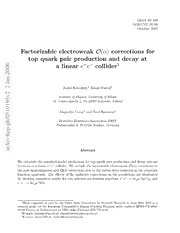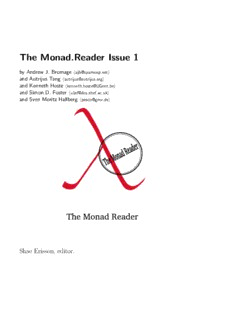
The Monad.Reader Issue 1 - Haskell PDF
Preview The Monad.Reader Issue 1 - Haskell
The Monad.Reader Issue 1 by Andrew J. Bromage hajb@spamcop.neti and Autrijus Tang hautrijus@autrijus.orgi and Kenneth Hoste hkenneth.hoste@UGent.bei and Simon D. Foster hu1sf@dcs.shef.ac.uki and Sven Moritz Hallberg hpesco@gmx.dei Shae Erisson, editor. Contents Pseudocode: Natural Style 6 Programming and Writing . . . . . . . . . . . . . . . . . . . . . . . . . . . . . 6 Refactor aggressively . . . . . . . . . . . . . . . . . . . . . . . . . . . . . 7 Natural transformations . . . . . . . . . . . . . . . . . . . . . . . . . . . 8 Programming Challenge . . . . . . . . . . . . . . . . . . . . . . . . . . . . . . 8 Pugs Apocryphon 1 – Overview of the Pugs project 10 What is this document about? . . . . . . . . . . . . . . . . . . . . . . . . . . . 10 What is Perl 6? . . . . . . . . . . . . . . . . . . . . . . . . . . . . . . . . . . . 10 Has Perl 6 been specified? . . . . . . . . . . . . . . . . . . . . . . . . . . . . . 10 What does ”Apocrypha”mean? . . . . . . . . . . . . . . . . . . . . . . . . . . 10 What is the relationship between Apocrypha and the Perl 6 design documents? 11 Will Pugs implement the full Perl 6 specification? . . . . . . . . . . . . . . . . 11 Is Pugs free software? . . . . . . . . . . . . . . . . . . . . . . . . . . . . . . . . 11 Is Pugs funded by the Perl Foundation? . . . . . . . . . . . . . . . . . . . . . 11 Where can I download Pugs? . . . . . . . . . . . . . . . . . . . . . . . . . . . 11 How do I build Pugs? . . . . . . . . . . . . . . . . . . . . . . . . . . . . . . . . 11 What is Haskell? . . . . . . . . . . . . . . . . . . . . . . . . . . . . . . . . . . 12 What is GHC? . . . . . . . . . . . . . . . . . . . . . . . . . . . . . . . . . . . 12 What is the Perl 6 bootstrapping problem? . . . . . . . . . . . . . . . . . . . . 12 What was the initial bootstrapping plan? . . . . . . . . . . . . . . . . . . . . . 12 What was the revised bootstrapping plan? . . . . . . . . . . . . . . . . . . . . 12 How can Pugs help Perl 6 to bootstrap? . . . . . . . . . . . . . . . . . . . . . 13 How can Pugs help the Perl 6 language design? . . . . . . . . . . . . . . . . . 13 Why did you choose Haskell? . . . . . . . . . . . . . . . . . . . . . . . . . . . 13 Is Pugs a compiler or an interpreter? . . . . . . . . . . . . . . . . . . . . . . . 13 Which compiler backends do you have in mind? . . . . . . . . . . . . . . . . . 13 Do you have a roadmap for Pugs development? . . . . . . . . . . . . . . . . . 14 How portable is Pugs? . . . . . . . . . . . . . . . . . . . . . . . . . . . . . . . 14 How fast is Pugs? . . . . . . . . . . . . . . . . . . . . . . . . . . . . . . . . . . 14 Is there a CPAN for Perl 6 modules? . . . . . . . . . . . . . . . . . . . . . . . 14 Can Pugs work with Perl 5 libraries? . . . . . . . . . . . . . . . . . . . . . . . 14 Can Pugs work with Haskell libraries? . . . . . . . . . . . . . . . . . . . . . . 15 Can Pugs work with C libraries? . . . . . . . . . . . . . . . . . . . . . . . . . 15 2 I know Perl 5, but not Haskell. Can I develop Pugs? . . . . . . . . . . . . . . 15 I know Haskell, but not Perl 5. Can I develop Pugs? . . . . . . . . . . . . . . 15 I have learned some Perl 6. What can I do with Pugs? . . . . . . . . . . . . . 15 Where can I learn more about Haskell? . . . . . . . . . . . . . . . . . . . . . . 15 Where can I learn more about Perl 6? . . . . . . . . . . . . . . . . . . . . . . 16 Where can I learn more about implementing programming languages? . . . . . 16 I’d like to help. What should I do? . . . . . . . . . . . . . . . . . . . . . . . . 16 An Introduction to Gtk2Hs, a Haskell GUI Library 17 Introduction . . . . . . . . . . . . . . . . . . . . . . . . . . . . . . . . . . . . . 17 What is Gtk2Hs? . . . . . . . . . . . . . . . . . . . . . . . . . . . . . . . . . . 17 The example program: Memory, the game . . . . . . . . . . . . . . . . . . . . 19 The GUI: Using Glade . . . . . . . . . . . . . . . . . . . . . . . . . . . . . . . 19 The code: reading the glade description. . . . . . . . . . . . . . . . . . . . . . 20 The code: what’s after Glade . . . . . . . . . . . . . . . . . . . . . . . . . . . 22 The code: setting up communication . . . . . . . . . . . . . . . . . . . . . . . 22 The code: playing the game . . . . . . . . . . . . . . . . . . . . . . . . . . . . 27 The code: playing with efficiency . . . . . . . . . . . . . . . . . . . . . . . . . 30 The game: really playing it . . . . . . . . . . . . . . . . . . . . . . . . . . . . 30 Conclusion . . . . . . . . . . . . . . . . . . . . . . . . . . . . . . . . . . . . . . 31 Implementing Web-Services with the HAIFA Framework 32 Introduction to HAIFA . . . . . . . . . . . . . . . . . . . . . . . . . . . . . . . 32 Components of HAIFA . . . . . . . . . . . . . . . . . . . . . . . . . . . . . . . 33 The Generic XML Serializer . . . . . . . . . . . . . . . . . . . . . . . . . 33 Hooks . . . . . . . . . . . . . . . . . . . . . . . . . . . . . . . . . . . . . 36 SOAP/1.1 . . . . . . . . . . . . . . . . . . . . . . . . . . . . . . . . . . . 37 Web-Service Publisher . . . . . . . . . . . . . . . . . . . . . . . . . . . . 37 Putting it all together . . . . . . . . . . . . . . . . . . . . . . . . . . . . . . . 38 Future Components . . . . . . . . . . . . . . . . . . . . . . . . . . . . . . . . . 39 XML Schema . . . . . . . . . . . . . . . . . . . . . . . . . . . . . . . . . 39 WSDL . . . . . . . . . . . . . . . . . . . . . . . . . . . . . . . . . . . . . 40 Composite Web-services . . . . . . . . . . . . . . . . . . . . . . . . . . . 40 Conclusion . . . . . . . . . . . . . . . . . . . . . . . . . . . . . . . . . . . . . . 40 References . . . . . . . . . . . . . . . . . . . . . . . . . . . . . . . . . . . . . . 41 Listing of Factorial Web-Service . . . . . . . . . . . . . . . . . . . . . . . . . . 42 Code Probe - Issue one: Haskell XML-RPC, v.2004-06-17 [1] 44 XML-RPC . . . . . . . . . . . . . . . . . . . . . . . . . . . . . . . . . . . . . . 44 Haskell XML-RPC . . . . . . . . . . . . . . . . . . . . . . . . . . . . . . . . . 45 Literate Programming, almost . . . . . . . . . . . . . . . . . . . . . . . . . . . 45 Short Reference . . . . . . . . . . . . . . . . . . . . . . . . . . . . . . . . . . . 45 Low-Level Structs . . . . . . . . . . . . . . . . . . . . . . . . . . . . . . . . . . 46 Meat of the Matter . . . . . . . . . . . . . . . . . . . . . . . . . . . . . . . . . 46 Conclusion . . . . . . . . . . . . . . . . . . . . . . . . . . . . . . . . . . . . . . 46 References . . . . . . . . . . . . . . . . . . . . . . . . . . . . . . . . . . . . . . 47 Pseudocode: Natural Style By Andrew J. Bromage – email: ajb@spamcop.net Welcome to Pseudocode! This this series of articles (hopefully monthly, assuming that I get around to it) serves two main purposes. Firstly, I’ll be presenting some“recreational programming”problems. Some of these problems will to illustrate something specific. Others will be just because it ticked my fancy, so to speak. Secondly, since I don’t keep a blog, this is my virtual soapbox. You see, dear reader, I subscribe to the Usenet Theory of Finding Things Out: Don’t ask, because people will ignore you. Post wrong information instead, and people will rush to correct you. So read on for this month’s wrong information. Programming and Writing I have a confession to make. I used to be a Perl hacker. It’snotsomethingthatI’mespeciallyproudof. But, asAlanPerlisputit, ifalanguage doesn’t change the way you think about programming, it’s not worth knowing. In that sense, being a reformed Perl hacker is something that I’m not ashamed of, either. One of the things that I learned from Perl is the relationship between programming languages and natural languages. In particular: Programming is writing. This should be obvious, but all the best ideas are. BackwhenItutoredundergraduatestudents, Iwasoftenaskedwhatconstitutes“good style”. It’s a hard question to answer, especially about a language like Haskell which, at the time, didn’t have a huge corpus of software to compare against. There was GHC, but it wasn’t exactly a shining example of readability at the time. (A lot of it arguably still isn’t.) A lot of it was written in monadic style, but was written before the advent of constructor classes, let alone do-notation. First-yearstudents find recursionhard enough to understand, let alone that. But for programming in a more common language, like C, the best analogy – and I wish I could remember who taught me this – was to writing in a native language. You, dear student, are being taught to write software. If we were teaching you to write novels, we would expect you to have read a few novels written by other people first. So read other peoples’ programs, but read them critically. Only this way will you learn “good style”. In my humble opinion, we don’t push this analogy far enough, though to our credit, we do teach students some of its more important aspects. For example, we drum into 5 them the idea that your program must be readable above all else. Your program, dear student, will be read by someone else, so try to make sure that they can. The typical student, of course, only learns this valuable lesson by being the next person, several months later. That was certainly true in my case. The writing analogy holds for professionals, too. Henry James famously said: “All writing is rewriting.” That’s also true of programming. All programming is reprogram- ming, only we tend to use other terms, like“cleaning up”,“maintaining”or“refactoring”. Refactor aggressively A phenomenon which you occasionally find on the Haskell mailing lists is what I call “micro-refactoring by committee”. Itstartswhenanewbieasks: “HowcanIimprovethisprogram?” Overthenextcouple of days, suggestions arrive, each more interesting than the previous. A conversation might start something like this: Hi. Can someone critique this code for me? Thanks! reverse [] = [] reverse (x:xs) = reverse xs ++ [x] To which someone will point out: Accumulator recursion is better in this case: reverse xs = rev’ xs acc where rev’ [] acc = acc rev’ (x:xs) acc = rev’ xs (x:acc) To which someone will reply: You should use foldl! reverse xs = foldl snoc [] xs where snoc xs x = x:xs And on the conversation will go until the program looks something like this: reverse = foldl (flip (:)) [] In the end, we’ll end up with an extremely short program, which the original poster, being a newbie, requires a nontrivial amount of effort to decipher. On one hand, this is a useful exercise. Acknowledging the multitude of ways to do something is good. On the other hand, the end result is usually quite silly. Yes, it’s great if we want to know the Kolmogorov complexity of reverse, but in our rush to explore the solution space, I wonder if we’re sometimes forgetting the rule that we drum into students: In writing code, readability is the most important thing! Or maybe there are just more ex-Perl hackers out there in Haskell land that we care to admit... Natural transformations If I may be so bold, I’m going to propose what I consider the most important rule of programming style. It doesn’t trump other rules, but rather, it’s the rule which helps you decide which other rules to apply. The rule is: Be natural. The biggest problem with the final version of reverse is that it’s unnatural. If I had to write that function from scratch, and assuming that it wasn’t in the Prelude and I didn’t already know the answer by heart, I would not do it that way. Partly, my native language flows from left-to-right across the page, and I tend to view any code which contains flip with deep suspicion, since it reverses the ”natural”order for me. Mostly, I strongly suspect that most code of this type is not written, but rather it’s translated into. I tend to see many uses of“point-free style”in the same light. It’s also one of the reasons why I’ve resisted using arrows: You don’t program in arrow style; you program in diagrams on paper, then translate that into arrow style. Any time you find yourself translating your code into some style, you increase the chances that the“next person”(who, you will recall, may well be yourself) will have to translate back into what you wrote originally. Of course I don’t mean“keep what you first wrote”. If you’re a fallible human, then the code that you write first certainly won’t be precisely the same as the code that gets released. But it does suggest that every time you modify, refactor or otherwise transform your code, you should be careful to maintain naturality. At any point, your program should be something that you could have written first time, assuming you were a more perfect programmer than you are. Programming Challenge Okay, enough ranting. On with this month’s problem. Take a list S. Delete some elements from the list. What you have left is a subsequence of S. For example, [1,3,2] is a subsequence of [2,1,2,3,2,1,3], because you can obtain the former by deleting elements from the latter. Consider the list [1,2,3,1,2,3,1]. This string contains all permutations of the list [1,2,3] as subsequences. It is also minimal, in the sense that there is no shorter sub- sequence which will do (though there are potentially many minimal subsequences). we will call such a list a shortest supersequence over the alphabet [1..3]. Let S(n) be the length of the shortest supersequence over the alphabet [1..n]. The task is to find out some interesting things about S(n). Any interesting thing will do, but as a suggestion: I Write a Haskell function to test if xs is a supersequence over the alphabet [1..n]. There’s an obvious algorithm which is O(n!length(xs)). Can you do better? I Write a Haskell function to produce the shortest supersequence over the alphabet [1..n]. I Find bounds on S(n). Clearly n is a lower bound. An upper bound is n2 −n+1. (Why?) Can you do better? How about a recurrence? I For the alphabet [1..n], find bounds on the number of shortest supersequences. (It must be a multiple of n!, for obvious reasons.) Email your findings to me by the 22nd of March, 2005, for credit in next month’s The Monad.Reader. Pugs Apocryphon 1 – Overview of the Pugs project Autrijus Tang – email: autrijus@autrijus.org The Pugs Apocrypha are a series of documents, written in question/answer format, to explain the design and implementation of Pugs. This document (PA01) is a higher-level overview of the project. What is this document about? The Pugs Apocrypha are a series of documents, written in question/answer format, to explain the design and implementation of Pugs. This document (PA01) is a higher-level overview of the project. What is Perl 6? Perl 6 is the next major revision of Perl, a context-sensitive, multi-paradigmatic, prac- tical programming language, designed by a team led by Larry Wall. The Pugs project has been enthusiastically welcomed by the Perl 6 team. Has Perl 6 been specified? By December 2004, most of Perl 6 has been specified as a series of Synopses. Although not considered final, it is now stable enough to be implemented. Many of the Syn- opses are based on Larry’s Apocalypses. Sometimes the design team releases Exegeses, which explain the meaning of Apocalypses. Pugs adheres to the Synopses, referring to Apocalypses or Exegeses when a Synopsis is unclear or imprecise. What does ”Apocrypha”mean? The word Apocrypha, from the Greek (cid:130)p(cid:236)krufoc, ”hidden”, refers to religious works that are not considered canonical, or part of officially accepted scripture. The proper singular form in Greek is Apocryphon. 9 What is the relationship between Apocrypha and the Perl 6 design documents? ApocalypsesandSynopsescoverthePerl6languageingeneral; Apocryphaarespecificto the Pugs implementation. Like Parrot Design Documents, Apocrypha will be constantly updated according to the status of Pugs. Will Pugs implement the full Perl 6 specification? Yes. PugsalwaystargetsthelatestrevisionofPerl6Synopses. Assoonasanewrevision or a new Synopsis is published, incompatibilities between Pugs and the new version will be considered bugs in Pugs. Is Pugs free software? Yes. It is available under both GPL version 2 and Artistic License version 2.0b5. Once the final version of Artistic 2.0 is released, Pugs will adopt it. Is Pugs funded by the Perl Foundation? No. After receiving three Perl Foundation grants on various projects, Autrijus decides it would be more helpful to donate time to the Perl 6 project by hacking Pugs, rather than asking TPF for money to do the same thing. Where can I download Pugs? For the very latest version of Pugs, check out the source from Subversion or darcs repositories. Periodic releases are available on CPAN under the Perl6-Pugs namespace. (By the way, if you’d like offline working with the Subversion repository, the svk client may be of interest. But using vanilla svn is fine.) How do I build Pugs? PugsusesthestandardMakefile.PLbuildsystem, asdetailedintheREADMEfile. Since Pugs is written in Haskell, you will need Glasgow Haskell Compiler (GHC) 6.2 or above. Please download a binary build for your platform; compiling GHC from source code can take a very long time.
Description:The list of books you might like

Do Epic Shit

$100m Offers

The Sweetest Oblivion (Made Book 1)

The 48 Laws of Power
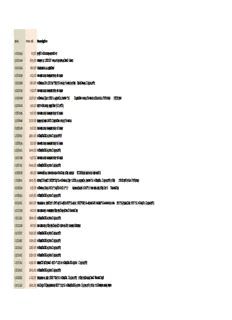
Arrow Prislista 2018.xlsx

Mary Baldwin College Magazine

Photography Second edition
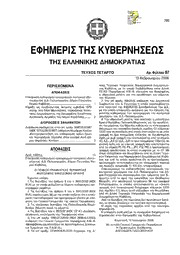
Greek Government Gazette: Part 4, 2006 no. 87

Bills as enacted, 2006-2007, No.81-151

The Echo
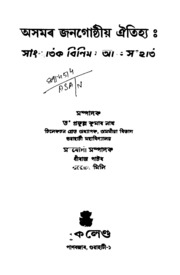
Sanskritik Binimay Aru Sanhati

aquatic weeds in the sudan

The Philosophic Grammar of American Languages by Daniel G Brinton

avoured Consumption in The Bloody Banquet
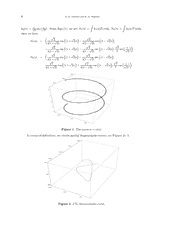
Special Smarandache Curves According to Bishop Frame in Euclidean Spacetime

A Luminous Home a Dismal House : Kudumba Vilakku & Irunda Veedu

The Humour of Holland
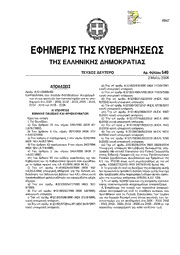
Greek Government Gazette: Part 2, 2006 no. 540
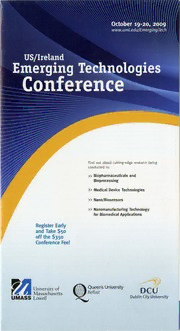
US/Ireland Emerging Technologies Conference Program

![A new species of the genus Polystoma (Polystomatidae, Monogenea) parasitic in Rana pleuraden Boulenges [Boulenger] book image](https://cdn.pdfdrive.to/media/content/thumbnails/a72260df-acae-48a6-9b1d-922d50398a65.webp)
